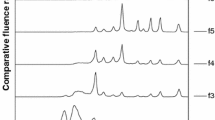Summary
Infectious DNA from phage T1 was inactivated by UV-light (2,537 Å). No effect of irradiation on the kinetics of the assay in a spheroplast system could be observed. UV-damaged molecules compete with unirradiated DNA for the infection. Infectious T1-DNA is subject to host-cell reactivation of UV-damage, the amount of which depends on the physiological conditions of the spheroplasts. Though UV-radiosensitivity of T1 particles is not influenced by the presence of the radical scavenging compound cysteamine, infectious DNA can be protected effectively by this chemical (0.01M) against UV-damage when HCR-negative spheroplasts are used for the assay. Incorporation of 5-bromouracil radiosensitizes infectious T1-DNA in the presence and absence of HCR. This effect can be eliminated when the DNA is irradiated in the presence of cysteamine. The mechanism of radioprotection is discussed.
Similar content being viewed by others
References
Blok, J., Sluys, J. van der, Cohen, J. A.: The effects of ionizing radiation on the biological activity of isolated DNA from bacteriophage. In: Biol. Effects of ionizing radiat. at the molecular level, Internat. Atomic Energy Agency, Wien, 1962, p. 359–370.
Boyce, R. P., Howard-Flanders, P.: The release of ultraviolet light-induced thymine dimers from DNA in E. coli K12. Proc. nat. Acad. Sci. (Wash.) 51, 293–300 (1964).
Eisinger, J., Shulman, R. G.: The precursor of the thymine dimer in ice. Proc. nat. Acad. Sci. (Wash.) 58, 895–900 (1967).
Ellison, S. A., Feiner, R. R., Hill, R. F.: A host effect on bacteriophage survival after ultraviolet irradiation. Virology 11, 294–296 (1960).
Harm, W., Rupert, C. S.: Infection of transformable cells of Haemophilus influenzae by bacteriophage and bacteriophage DNA. Z. Vererbungsl. 94, 336–348 (1963).
Hershey, A. D., Chase, M.: Independent functions of viral protein and nucleic acid in growth of bacteriophage. J. gen. Physiol. 36, 39–56 (1952).
Hotz, G.: Suppression by cysteamine of radiosensitization in 5-bromo-deoxyuridine substituted phage T1. Biochem. biophys. Res. Commun. 11, 393–398 (1963).
—: Photoreactivation of UV-damage in phage containing 5-bromouracil-DNA. Z. Vererbungsl. 95, 211–214 (1964).
—: Der Einfluß von Sauerstoff auf den direkten Effect von 60Co-Gammastrahlung bei der Inaktivierung von Phagen-Nukleinsäure. Stud. biophys. 12, 49–57 (1968a).
—: UV-sensitization of phage ϕX-174 by 5-bromouracil. Molec. Gen. Genetics 102, 39–43 (1968b).
—: On the mechanism of radiosensitization by 5-bromouracil. Studies on 60Co-gamma irradiated phage ϕX-174 and its single-stranded infectious DNA. Molec. Gen. Genetics 102, 44–49 (1968c).
—, Mauser, R.: Infectious DNA from coliphage T1. I. Some properties of the spheroplast assay system. Molec. Gen. Genetics 104, 178–194 (1969).
—, Reuschl, H.: Damage to deoxyribose molecules and to U-gene reactivation in UV-irradiated 5-bromouracil-DNA of phage T4Bo r as influenced by cysteamine. Molec. Gen. Genetics 99, 5–11 (1967).
Hotz, G., Walser, R.: On the mechanism of radiosensitization by 5-bromouracil. The occurrence of DNA strand breaks in UV-irradiated phage T4 as influenced by cysteamine. Photochem. Photobiol. (1970), (in press).
—, Zimmer, K. G.: Experiments in radiation chemistry of T1-phage. Int. J. Radiat. Biol. 7, 75–86 (1963).
Jansz, H. S., Pouwels, P. H., Rotterdam, C. van: Sensitivity to ultraviolet light of single- and double-stranded DNA. Biochim. biophys. Acta (Amst.) 76, 655–657 (1963).
Köhnlein, W., Hutchinson, F.: ESR-studies of normal and 5-bromouracil-substituted DNA of Bacillus subtilis after irradiation with ultraviolet light. Radiat. Res. 39, 745–757 (1969).
McLaren, A. D., Shugar, D.: Photochemistry of proteins and nucleic acids. London: Pergamon Press 1964.
Mennigmann, H.-D.: Inaktïvierung BUdR-substituierter transformierender DNS durch monochromaticches UV-Licht verschiedener Wellenlängen. Molec. Gen. Genetics 99, 76–87 (1967).
Okubo, S., Romig, W. R.: Comparison of ultraviolet sensitivity of Bacillus subtilis bacteriophage SPO2 and its infectious DNA. J. molec. Biol. 14, 130–142 (1965).
Patrick, M. H., Rupert, C. S.: The effects of host-cell reactivation on assay of UV-irradiated Haemophilus influenzae transforming DNA. Photochem. Photobiol. 6, 1–20 (1967).
Radman, M., Roller, A., Errera, M.: Protection and host cell repair of irradiated lambda phage. I. Irradiation of normal phage with ultraviolet light. Molec. Gen. Genetics 104, 142–147 (1969).
Reiter, H., Strauss, B.: Repair of damage induced by a monofunctional alkylating agent in a transformable, ultraviolet-sensitive strain of Bacillus subtilis. J. molec. Biol. 14, 179–194 (1965).
Rupert, C. S.: Photoreactivation of ultraviolet damage. In: A. C. Giese, Photophysiology, vol. II, p. 283–327 New York: Academic Press 1964.
Rupp, W. D., Prusoff, W. H.: Incorporation of 5-iodo-2-deoxyuridine into bacteriophage T1 as related to ultraviolet sensitization or protection. Nature (Lond.) 202, 1288–1290 (1964).
Sauerbier, W.: The influence of 5-bromodeoxyuridine substitution on UV-sensitivity, host-cell reactivation, and photoreactivation in T1 and P22H5. Virology 15, 465–472 (1961).
—: The influence of the metabolic state of the host bacteria on the survival of phage T1 irradiated with ultraviolet light. Virology 17, 164–170 (1962).
Setlow, R. B., Carrier, W. L.: The disappearance of thymine dimers from DNA: An errorcorrecting mechanism. Proc. nat. Acad. Sci. (Wash.) 51, 226–231 (1964).
Stephan, G., Miltenburger, H. G., Hotz, G.: UV-strahlenbedingte Brüche in 5-Bromuracil-substituierter DNS des Phagen T1. Z. Naturforsch. (1970), (in press).
Author information
Authors and Affiliations
Additional information
Communicated by E. Witkin
Rights and permissions
About this article
Cite this article
Hotz, G., Mauser, R. Infectious DNA from coliphage T1. Molec. Gen. Genet. 108, 233–242 (1970). https://doi.org/10.1007/BF00283353
Received:
Issue Date:
DOI: https://doi.org/10.1007/BF00283353




